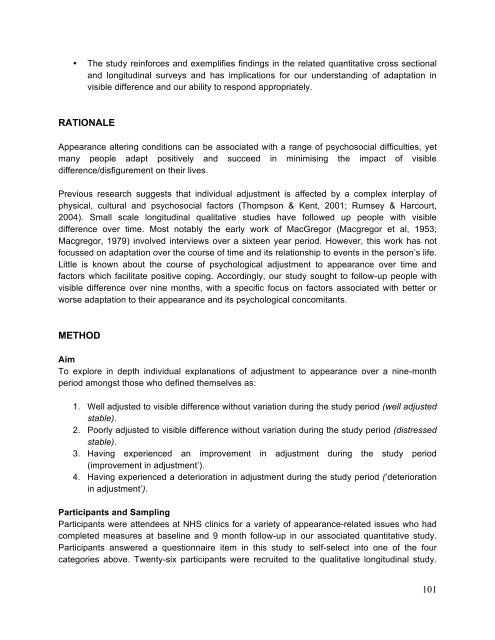Download the report - The Healing Foundation
Download the report - The Healing Foundation
Download the report - The Healing Foundation
You also want an ePaper? Increase the reach of your titles
YUMPU automatically turns print PDFs into web optimized ePapers that Google loves.
• <strong>The</strong> study reinforces and exemplifies findings in <strong>the</strong> related quantitative cross sectional<br />
and longitudinal surveys and has implications for our understanding of adaptation in<br />
visible difference and our ability to respond appropriately.<br />
RATIONALE<br />
Appearance altering conditions can be associated with a range of psychosocial difficulties, yet<br />
many people adapt positively and succeed in minimising <strong>the</strong> impact of visible<br />
difference/disfigurement on <strong>the</strong>ir lives.<br />
Previous research suggests that individual adjustment is affected by a complex interplay of<br />
physical, cultural and psychosocial factors (Thompson & Kent, 2001; Rumsey & Harcourt,<br />
2004). Small scale longitudinal qualitative studies have followed up people with visible<br />
difference over time. Most notably <strong>the</strong> early work of MacGregor (Macgregor et al, 1953;<br />
Macgregor, 1979) involved interviews over a sixteen year period. However, this work has not<br />
focussed on adaptation over <strong>the</strong> course of time and its relationship to events in <strong>the</strong> person’s life.<br />
Little is known about <strong>the</strong> course of psychological adjustment to appearance over time and<br />
factors which facilitate positive coping. Accordingly, our study sought to follow-up people with<br />
visible difference over nine months, with a specific focus on factors associated with better or<br />
worse adaptation to <strong>the</strong>ir appearance and its psychological concomitants.<br />
METHOD<br />
Aim<br />
To explore in depth individual explanations of adjustment to appearance over a nine-month<br />
period amongst those who defined <strong>the</strong>mselves as:<br />
1. Well adjusted to visible difference without variation during <strong>the</strong> study period (well adjusted<br />
stable).<br />
2. Poorly adjusted to visible difference without variation during <strong>the</strong> study period (distressed<br />
stable).<br />
3. Having experienced an improvement in adjustment during <strong>the</strong> study period<br />
(improvement in adjustment’).<br />
4. Having experienced a deterioration in adjustment during <strong>the</strong> study period (‘deterioration<br />
in adjustment’).<br />
Participants and Sampling<br />
Participants were attendees at NHS clinics for a variety of appearance-related issues who had<br />
completed measures at baseline and 9 month follow-up in our associated quantitative study.<br />
Participants answered a questionnaire item in this study to self-select into one of <strong>the</strong> four<br />
categories above. Twenty-six participants were recruited to <strong>the</strong> qualitative longitudinal study.<br />
101


